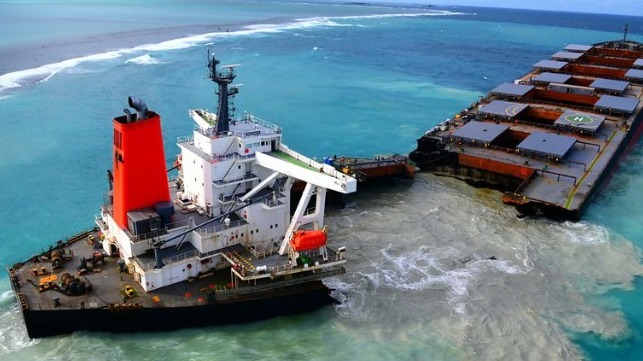Wakashio Shows Need for Spill Response Plans in Western Indian Ocean

The environmental catastrophe caused by the grounding of the bulk carrier Wakashio off Mauritius was among the worst maritime casualties of 2020. The resulting fuel spill received wide media coverage - and for a good reason, as the bunker fuel spread into pristine coastal habitats characterized by their ecological sensitivity, like Mauritius’ Blue Bay Marine Park.
The East African seaboard is increasingly becoming an international shipping route for crude oil as more offshore oil deposits are discovered and exploited. Thus, the risk of another major spill - similar to that of the Wakashio - runs high if contingency plans to improve preparedness and response are not implemented.
This was the focus of a recent report released by ISS (Institute for Security Studies), which found that the national contingency plans for most countries in the Western Indian Ocean fall short of the preparation required to avert or control marine pollution incidents.
The report also notes that the mere existence of a national oil spill contingency plan cannot stop the devastating impacts of an oil pollution event, as evident in Mauritius, which was swift to respond to Wakashio spill but got overwhelmed due to the level of resources and capacity required. India, France, Japan and International Maritime Organization had to chip in and supplement clean-up operations. Periodic national capacity building exercises are required to properly respond to marine pollution emergencies.
Although regionally there exists an emergency protocol for combating marine pollution under the Nairobi Convention of 1996, the framework envisaged in the protocol for regional cooperation and notification procedures remains a pipe dream. A 2012 Regional Cooperation Agreement for Oil Spill monitoring between countries in the Western Indian Ocean - among them Comoros, Kenya, Madagascar and Mauritius - has failed to materialize against a backdrop of insufficient resources, lack of standardized frontline responder training and scenario-based drills.
Besides regional cooperation on marine pollution incidents, there is a need to help countries in the Western Indian Ocean develop their individual national capabilities. This was one of the primary agenda items during a workshop held in Zanzibar (Tanzania) earlier this year between IMO and the Nairobi Convention Secretariat.
The workshop called for establishment of a Regional Coordination Center (RCC) for Marine Pollution Preparedness and Response in WIO region. This would help in coordinating information exchanges amongst countries in the region as well as designing and running of national and regional training courses and exercises. Additionally, the center would help fast track drafting of the Regional Contingency Plan (RCP) to serve as a basis for regional cooperation in preparedness and response to major marine pollution emergencies.
Since 2011, South Africa has shown willingness to host the RCC under the South African Maritime Safety Authority (SAMSA) but a bureaucratic hitch in signing of a host country agreement delayed the plan. However, without a solid funding mechanism for the center, its viability is unlikely.
A similar center hosted in Madagascar was established by a Global Environment Fund project following a ministerial decision in 2003 of the member countries of the Indian Ocean Commission (IOC), but it did not last.
Brian Gicheru Kinyua is a freelance writer based in Mombasa City, Kenya where he researches and writes on logistics and the African Blue Economy. His primary focus is on shipping and ports development in Sub-Saharan Africa and how it fits into the global maritime order. He also provides consulting services in communications and public relations.
The opinions expressed herein are the author's and not necessarily those of The Maritime Executive.

